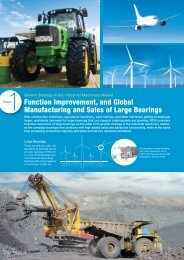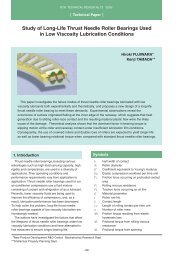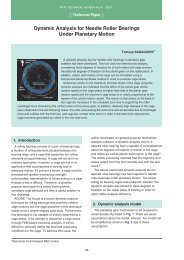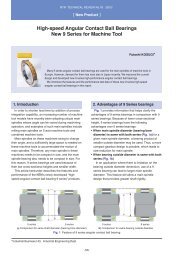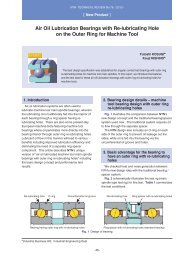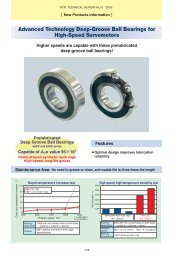Special Issue; Products for Industrial Machinery - NTN
Special Issue; Products for Industrial Machinery - NTN
Special Issue; Products for Industrial Machinery - NTN
You also want an ePaper? Increase the reach of your titles
YUMPU automatically turns print PDFs into web optimized ePapers that Google loves.
<strong>NTN</strong> TECHNICAL REVIEW No.742006<br />
2) Cage with improved mechanical strength<br />
A fall impact test was per<strong>for</strong>med and determined<br />
that the resin cage excels in mechanical strength<br />
compared to the current <strong>NTN</strong> steel plate cage type,<br />
which has been per<strong>for</strong>ming well and has been<br />
accepted favorably in the bearing market.<br />
Test conditions<br />
Table 2 Condition of fall impact test<br />
Vibration acceleration (m/s 2 )<br />
Fall cycle frequency (cpm)<br />
9800 (fall height: 80 mm)<br />
30<br />
2.3 Verification of the effectiveness of antifretting<br />
measures<br />
The state of the backing rings after an endurance<br />
test was investigated. As a result, we learned that our<br />
anti-fretting measure is effective.<br />
Test conditions<br />
Table 3 Test condition of prevention of fretting test<br />
Bearing speed (min -1 )<br />
Radial load (kN)<br />
Axial load (kN)<br />
Run duration (h)<br />
2125 (equivalent to train operation at 330 km/h)<br />
54.9<br />
6.5<br />
7273<br />
Test results<br />
Test bearing<br />
Vibration-isolating<br />
pneumatic spring<br />
Fig. 3 Fall impact test machine<br />
Backing<br />
ring<br />
Anti-fretting<br />
backing ring<br />
Standard<br />
backing ring<br />
Fig. 5 Form of backing ring width after examination<br />
Test results<br />
Number of fall cycles<br />
400000<br />
300000<br />
200000<br />
100000<br />
0<br />
Test was suspended after 360,000 cycles<br />
Crack occurrence after 93,000 cycles<br />
Steel cage<br />
Resin cage<br />
2.4 Verification of the effectiveness of a light<br />
contact seal<br />
Through rotation tests, the run temperature on the<br />
light contact seal was compared with that of a<br />
standard seal (with spring). As a result, it was<br />
discovered that compared with the standard seal, the<br />
lip temperature of the light contact seal is about 20°C<br />
lower. (The temperature measurement point was<br />
about 2 mm directly beneath the lip on the seal sliding<br />
section.)<br />
Fig. 4 Test result of fall impact test<br />
Standard seal<br />
Light contact seal<br />
Fig. 6 Shape of oil seal<br />
-86-


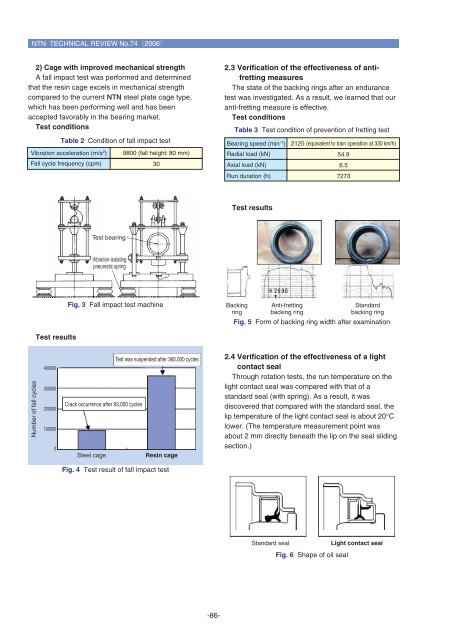
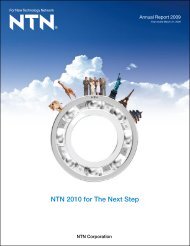
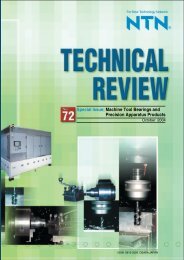
![[New Product] Unit Products for Office Equipment - NTN](https://img.yumpu.com/27154451/1/184x260/new-product-unit-products-for-office-equipment-ntn.jpg?quality=85)
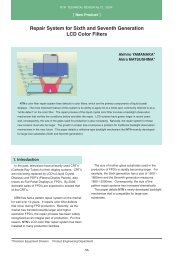
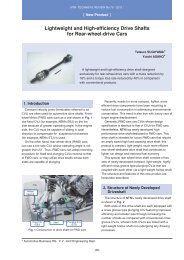
![[New Product] Development of Oil-impregnated Sintered ... - NTN](https://img.yumpu.com/27154427/1/184x260/new-product-development-of-oil-impregnated-sintered-ntn.jpg?quality=85)

